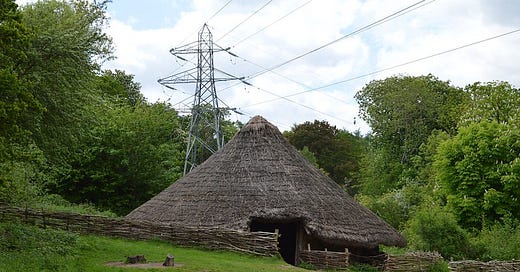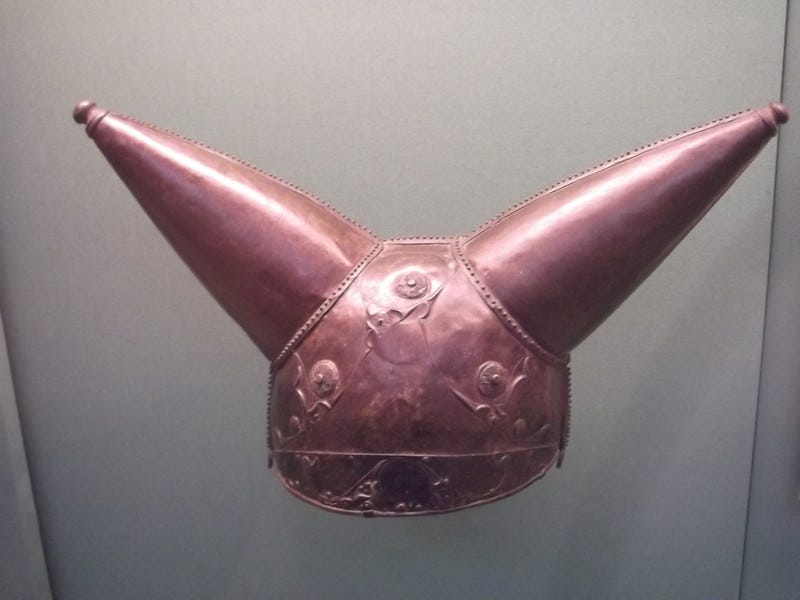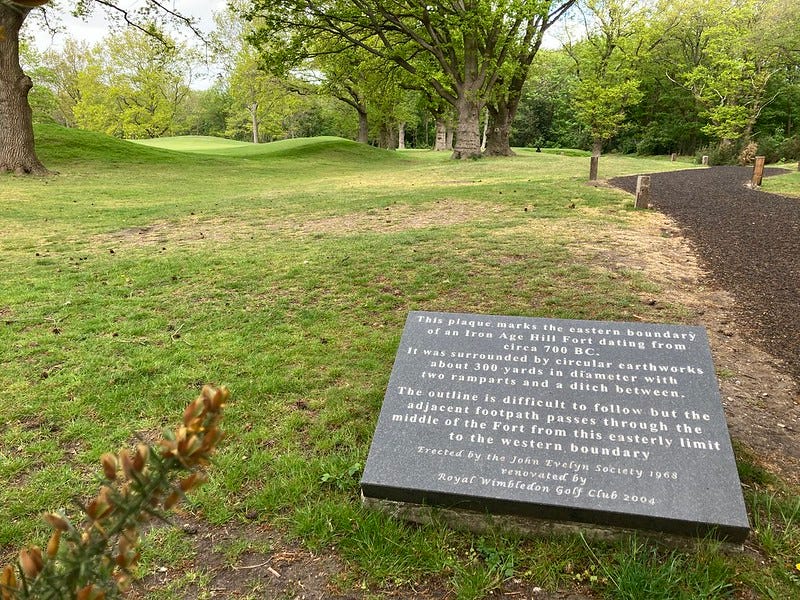Today, we’re dialling the time machine back further than we’ve ever gone before, into the realms of pre-history; to a time before London itself existed. That’s for the main feature, but first a quick message:
📣📣 Time for another Londonist: Time Machine drinks meetup. If you want to meet other London history fans and have a chinwag in an historic London pub (or two… we usually do a mini-pub crawl), then save the date of Wednesday 1 May. This is for paying subscribers only, with more details to follow in the Friday newsletter. I’m also looking into arranging a couple more site visits to historic museums/venues for paid subscribers in the May/June timeframe.
What was in London *Before* London?
We will never know who constructed the first building in London, or where, but it probably looked something like this:
This is a reconstruction1 of an Iron Age roundhouse, a circular wooden building typically inhabited by a large family group. (I’m no expert, but I think the electricity pylon might be not be true-to-period.) Hundreds of these houses would once have dotted the London region. We’re looking at the distant ancestor of the suburban semi.
The history of London is usually reckoned to begin around AD43 with the coming of the Romans and the foundation of Londinium. But humans had been wandering these gentle hills for ten-thousand generations.
The earliest Londoners left little trace. We know they were here from their discarded tools and occasional human remains. They lived a hunter-gatherer existence, peripatetic, with no permanent home. One of them dropped a hand axe on what, 350,000 years in the future, would become Gray’s Inn Road. Their lives, their loves, their motivations remain almost entirely mysterious.
By about 4,000BC the first family groups settled down to farm the land and raise livestock. They probably lived in isolated pockets rather than villages or towns, but they must have occasionally gathered in larger groups, as recent evidence from a Shoreditch dig suggests. By the time Julius Caesar popped over in 54BC, a sophisticated Celtic society was in place.
Today, I’m going to look at the centuries immediately before the coming of the Romans, a time when most of England was dominated by Celtic culture. This era encompasses the Iron Age (roughly 800BC to the full-scale Roman conquest of 43AD) and the Late Bronze Age (the two or three centuries before the Iron Age). What did ‘London’ look like over this period? Who was living here? And, to paraphrase Spinal Tap, what were they doing?
Around the local ‘hood
Then as now, the London region was dominated by the River Thames. But it was a very different river; both wider and shallower, unencumbered by embankments, bridges, or any kind of stonework. You could have waded across in places. It teemed with life.
To the north, the river would have lapped much closer to Strand (a name which indicates a shoreline), Fleet Street and Trafalgar Square. In the Square Mile, the river washed inland far enough to submerge Thames Street. Behind, the land rose quickly to form the mounds we would later call Ludgate Hill, Cornhill and Tower Hill.
Much of south was marshy, and remained so until early modern times. The tides swept well inland, creating dozens of islands and channels. It must have been a paradise for wading birds, and perhaps for early hunters. We get a sense of this inchoate shoreline in a famous illustration by Peter Froste, made for the Museum of London:

This view is of Roman Londinium, but it captures the essence of prehistoric south London (left), which remained a semi-flooded chain of islands up to medieval times. Places to the north and east like Stepney and the Isle of Dogs would have been similarly inundated with each tide.
The heart of Westminster, famously, was also an island. It was known as Thorney because — it’s usually assumed — it was a bit thorny. For reasons lost to history, a monastery was established here which, with the aid of some thorn-busting secateurs and a bit of cajoling from Edward the Confessor, grew into Westminster Abbey. The Palace of Westminster soon followed. The surrounding rivulets, actually arms of the River Tyburn, would be gradually filled in until only historians remembered it as an island.
Speaking of rivers, they were everywhere. The Fleet, Tyburn, Ravensbourne, Effra, Walbrook, and many others drained into the Thames. Here’s a simplistic map I put together to show some of these rivers. For interest, it also includes some of the modern place names that reference the rivers (e.g. Knightsbridge really was a bridge over the Westbourne).
As you can see, Iron Age wanderers could not have gone far without encountering a watery barrier. London’s earliest bridges would have been simple wooden structures spanning these waterways. Most of London’s rivers carry medieval names but one, the Brent (top left), is thought to come from a Celtic term such as brigant, meaning high or elevated. Celtic place names are very rare in London. Almost everything around us was named by the Anglo-Saxons or later Londoners. Only the Brent (and thereby Brentford), the Thames and the south London area of Penge2 can trace their names back to a Brittonic tongue.
For most of the period, there were no villages or towns to speak of. People lived together in large family groups, dotted throughout the landscape. They were farmers, tending crops and livestock. Later, some gathered together into small, fortified communities called oppida. These may have been connected by wooden trackways, sections of which are occasionally found in the archaeological record. Some of these early roads may have been reused and resurfaced by later Roman engineers.
The natural history of before-London
Away from the Thames, much of the London area would have been covered in trees. But these ancient woodlands would have been subtly different to the greenery we see today. No horse chestnuts, for example. They didn’t reach our shores until Shakespeare’s time. Pears, plums and cherries would not blossom here until the Romans brought them over. London plane trees — now the commonest large tree in the city centre — did not exist anywhere. The two parents of this hybrid were growing in blissful ignorance of one another, thousands of miles apart in Asia and North America. They would not meet until the 17th century. Archaeologists have found a surprising number of yew trees along the foreshore, mixed in with oak and hazel — not a combination found in local woods today.
It was long assumed that the Romans also brought over the stinging nettle, which was used as a food, herbal remedy and, apparently, for flagellation. However, nettle fibres have been found in Bronze Age burials, indicating that the species may have been native after all.
Early Londoners would have been much more aware of the wildlife around them, and some of it would surprise a modern Londoner. Wolves would have been numerous, along with beavers and lynx. The last aurochs — giant cattle — roamed the grasslands on the edge of the woods for part of the Bronze Age. They were extinct, however, by 1500BC.
No rabbits hopped among the undergrowth. They were introduced by the Normans, or perhaps the Romans, as were fallow deer. Certainly, our forebears never knew the screech of the parakeet, the guile of the grey squirrel or the menace of the black rat. None of these creatures is indigenous to Britain.
Who were the first Londoners?
Iron Age Britain was a tribal place. Large areas of land were divided up (and no doubt disputed) between many different groups. We know some of their names — or approximations to their names — from Roman accounts. The tribe best-known today is surely the Iceni of Norfolk, whose ruler Boudicca became the first named woman in London’s history by putting the nascent town to the torch. But other tribes claimed territorial rights over what is now London, most importantly the Catuvellauni and Trinovantes.
Julius Caesar was the first to describe the people of south-east England, including the London region, during his brief campaign of 54BC. He compliments the charioteers and describes a well-drilled soldiery. But he also has plenty to say about wider society, as he saw it:
“The number of the people is countless and their buildings exceedingly numerous, for the most part very like those of the Gauls... They do not regard it lawful to eat the hare, and the cock, and the goose; they, however, breed them for amusement and pleasure.”
“Most of the inland inhabitants do not sow corn, but live on milk and flesh, and are clad with skins. All the Britons, indeed, dye themselves with woad, which occasions a bluish colour, and thereby have a more terrible appearance in fight. They wear their hair long, and have every part of their body shaved except their head and upper lip. Ten and even twelve have wives common to them, and particularly brothers among brothers, and parents among their children; but if there be any issue by these wives, they are reputed to be the children of those by whom respectively each was first espoused when a virgin.”
A bunch of rowdy inbreds, then… and with moustaches! It’s important to note here that we can’t take Caesar’s words at face value. Little of what he says is backed up by archeology or other sources, and he undoubtedly had political reasons for painting the Brits as barbarians. Still, it’s the best written account we have of life in Iron Age ‘London’.
Archaeological finds
In the absence of written evidence, we must turn to archaeological finds. Much of this has come from the Thames. The oldest surviving structure in London can be found at Vauxhall beneath the MI6 building at the lowest tides. These are the remains of a timber jetty, located right where the River Effra would have debouched into the Thames. Its wood has been carbon dated to 4,500 BC, a rare neolithic structure more than a thousand years older than Stonehenge. Further wooden supports are preserved in the mud a few hundred metres upstream, and are thought to be from a bridge structure of around 1,500 BC.
Later Londoners also left their marks on the river. The glorious Battersea Shield was discovered during works to build Chelsea Bridge in 1857. It’s been dated to the first or second century BC — which makes it a possible witness to the incursion by Julius Caesar. Archaeologists believe the shield was left in the river as a votive offering, however.
It gets better. The horned helmet below is not, as an excitable seven-year-old might cry, a relic of the Viking era. Nor is it a relic of Madonna’s pointy phase. It’s another Celtic artifact, of similar vintage to the shield. The bronze headgear was found more centrally, at Waterloo Bridge, in 1868. It’s the only horned helmet of the period ever found in Europe. But, like the shield, it would not have been used militarily. It is too fragile to hold up against a weapon. Historians think it was ceremonial, or perhaps it decorated a statue.
These are merely the most photogenic items of prehistory from central London. Many others have been unearthed. A dagger at Newgate; an axe on Bouverie Street. Bronze age pottery and tools have been found in the Square Mile, suggesting some degree of settlement. Hints at a possible roundhouse have even been discovered in Park Street, Southwark — curiously, the same street on which one of the world’s most famous circular building, the Globe Theatre, would be constructed thousands of years later.
It’s quite possible that the Square Mile was extensively inhabited by Iron Age people before the Romans built Londinium there. It’s the perfect place. Here we find a series of defendable hills (Cornhill, Ludgate, Tower Hill) close to the river, and at a point that’s still reasonably narrow. There are no such hills north of the river for many miles. But evidence is always going to be hard to come by. Imagine, say, a Celtic tribe had built a decent-sized fort on top of Ludgate Hill. Any remnants would have been destroyed long ago, or else lie buried beneath the foundations of St Paul’s Cathedral where no archaeologist is ever likely to venture a shovel.
Still, we hear echoes here and there. The church of St Bride’s, so it’s said, was built over a sacred spring to the Celtic goddess Brigit, hence the name. London Stone, the mysterious hunk of rock ensconced on Cannon Street, is also touted as a pre-Roman Druidic stone by people without any real evidence. But maybe?
Much of Celtic London has undoubtedly been lost to centuries of development. But move further out, and the archaeology gives itself up more readily. If you’ve ever visited Epping Forest, then you might have chanced across its two iron age forts of Ambresbury Banks and Loughton Camp (in truth, there’s not much to see other than some artificially raised earth, but still). Heathrow Airport has yielded many interesting discoveries, including the remnants of an Iron Age fort. And then Wimbledon Common has the inaccurately named Caesar’s Camp, yet another Iron Age fortification that now serves as London’s most venerable golfing hazard:
Huge Iron Age ditches have been excavated at Woolwich Arsenal. Putney shows abundant evidence of settlement, including weaponry, beads and another fine shield.
Uphall Camp beside the River Roding in Ilford was colossal in comparison to the above settlements — a mile in circumference. The remains of numerous roundhouses have been found within its bounds, as well as pottery and coins. It’s all built over now. If I owned any of the houses between Victoria Road and Wingate Road in Ilford, I’d be digging my flower beds a little deeper than is customary, in the hope of finding some ancient treasure.
The biggest pre-Roman hoard of all, though, comes from a few miles east in Rainham. The so-called Havering Hoard, discovered in 2018, contains 453 items that had lain undisturbed for 3,000 years. Daggers, swords, tools… nobody knows why these everyday items were buried en masse near the banks of the Thames. The collection was put on display at the Museum of London Docklands in 2020. Around the same time, a cache of late Iron Age coins were found at an HS2 dig site in Hillingdon.
Pre-Roman London remains a mysterious place. Many isolated discoveries have been made, though the overall picture remains fragmentary. Yet new archaeological surprises turn up all the time. For all we know, a full-on Iceni chariot might lie a few metres beneath the soil in some undisturbed corner of the City fringes. Boudicca herself may still be among us, hidden 2000 years beneath the accretions of the ages. Or maybe there really is a roundhouse lurking beneath a pylon somewhere.
We’ve merely peeped behind the Iron-Age curtain. The best discoveries, I suspect, are yet to come…
Thanks for reading! As ever, I’d be delighted to read your comments in the section below. Or email me on matt@londonist.com about this or any other aspect of London history.
The house can be inspected at the wonderful Chiltern Open Air Museum, which collects together small buildings (most genuine, unlike the roundhouse) from different eras and locations.
People often say “Penge” with a slightly derisory or comical tone of voice. I wonder if it sounds so peculiar because it’s from a different linguistic origin to almost all other London place names. It’s thought to mean ‘edge of wood’.











ey just meant island. In fact it became ey-land. (Someone added the S later because they confused it with isle, which is a French word.) So Thorney Island was Thorn island island land. Chelsea might be chalk island and Battersea might be Baldric's island. If Baldric can have an island, maybe Thor had one as well, though "thorns" does seem a more likely derivation.
Fascinating, Matt. It reminded me of this excerpt about Dartmoor from The Hound of the Baskervilles, which is a little further afield from London, but seems to hold similar prehistoric treasures:
The whole steep slope was covered with gray circular rings of stone, a score of them at least.
“What are they? Sheep-pens?”
“No, they are the homes of our worthy ancestors. Prehistoric man lived thickly on the moor, and as no one in particular has lived there since, we find all his little arrangements exactly as he left them. These are his wigwams with the roofs off. You can even see his hearth and his couch if you have the curiosity to go inside.”
“But it is quite a town. When was it inhabited?”
“Neolithic man—no date.”
“What did he do?”
“He grazed his cattle on these slopes, and he learned to dig for tin when the bronze sword began to supersede the stone axe. Look at the great trench in the opposite hill. That is his mark. Yes, you will find some very singular points about the moor, Dr. Watson.”
I was also reminded of the historic fiction novel London, by Edward Rutherford (https://amzn.to/49we9M7). It follows generations of families from the Roman times, opening with a chapter on the geological formation of the region.